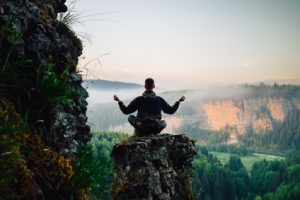If you are thinking of beginning a mindfulness practice, you might wonder where to start and what classes or programs will work best for you. You might also want some basic information about the benefits that you can expect. We’ve put together a little primer to help you on your way.

meditation
First, congratulations on your decision to look at mindfulness meditation, there are enormous benefits to living your life with awareness. Here are just some of the benefits that you can expect with a sustained mindfulness practice.
- Stress reduction
- Memory improvement
- Focus
- Emotional intelligence
- Empathy
- Compassion
- Greater immune function
What is Mindfulness Meditation
For the purpose of this article, mindfulness meditation is the secular practice developed by Jon Kabat-Zinn. Basically, Mindfulness practices bring non-judgemental awareness to the present, helping us to experience our lives on a moment-to-moment basis.
For a more detailed explanation of the practice
Where to Start
You might want to totally immerse yourself in a new practice, or you might be a little tepid about mindfulness meditation and want to begin slowly.
For those who’d like to get their feet wet, before jumping into the deep end of the pool, we’ve included a simple exercise below.
Note:
This exercise is intended to give you a taste of mindfulness meditation. It is not of itself a teaching on mindfulness meditation.
Exercises
Sitting Meditation – Duration: 5 – 10 min.
We begin by finding a comfortable position to sit.
Sitting: Find a comfortable place to sit with your back straight, spine aligned with your base. You can sit on the floor, a zafu (meditation cushion), or in a straight chair. If you prefer, you can sit lotus style with your legs crossed and hands folded in your lap.
Method:
It all starts with a single breath.
Close your eyes and focus your attention on the in and out-breath through your nose. Notice the qualities of your breath, for example: cold while breathing in, warm while exhaling.
Don’t hold on too tight to the awareness of your breath, the idea here is to establish some base concentration point so that we can begin to notice what arises in our mind.
Thoughts and feelings will arise, try to notice them without judgment and return your mind gently to the breath. Don’t become frustrated if you notice that you lost all focus and have drifted off following one of your thoughts, simply return to your breath.
When you notice that your mind has wandered and you return to your breath, you have just taken your first mindful step. It was your awareness that brought you back!
Lather, rinse, repeat
Continue watching your breathing and noticing thoughts and feelings arise.
How does this help
This meditation helps improve focus and awareness. It also puts some distance between us and our thoughts or emotions. This distance that we gain ultimately allows us to be less reactive to the content of thoughts and emotions, giving us space to determine what our reaction should be.
When will you see results
If you continue to do the meditation above daily (if possible) for a couple of weeks, you should begin to notice some subtle changes. If you continue to practice and find classes or a program near you, you will undoubtedly change many aspects of your life for the better.
Classes and Programs
There are many groups, classes, and programs on mindfulness meditation available. It’s very likely that you will be able to find one near you. The Jon Kabat-Zinn based program is typically referred to as MBSR (Mindfulness Based Stress Reduction).
A few things to consider before searching for a class
- Not all instructors are equally qualified. Be sure to check out their credentials (MBSR certified, etc.)
- Classes are available online.
- Most programs run 8 – 12 weeks, some are primarily on-site, others are a combination of on-site and online teachings.
- You can find single session offerings locally as well.
- There is a Buddhist practice of mindfulness meditation that differs from the practice described in this document. ( Just a point of clarity to help in your search).


